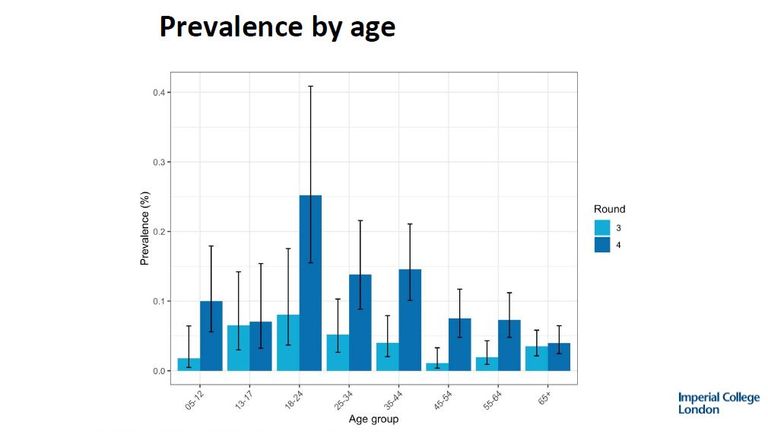The rate of COVID-19 transmission has risen above a critical level that means the infection is growing exponentially, official figures show.
The latest estimate for the R number across the UK is between 1.0 and 1.2, according to the Scientific Advisory Group for Emergencies (SAGE),
The last time it was above one was in early March.
The R number represents the average number of people each person with coronavirus goes on to infect.
Follow live coverage of the latest coronavirus news and updates
The number of new UK cases also continues to rise, with a near four-month high of 3,539 recorded on Friday - up from 2,919 the day before.
There were also six more deaths, taking the total to 41,614.
A higher incidence of cases is being seen in people 18 to 24 years old, and there are fears the reopening of schools and universities will accelerate the spread.
It comes as a ban on gatherings of more than six is due to start Monday, while households will be barred from meeting each other in Birmingham, Sandwell and Solihull from Tuesday after a rise in cases in the area.
Lockdown measures are also being tightened from midnight in Lanarkshire, the Scottish government said.
Separate data, which fed into the SAGE number, suggests cases are doubling every week in England and the R number could be as high as 1.7.
Scientists reinforced the need for the "rule of six" for social gatherings.
Infection levels were examined in the general population in England after more than 150,000 volunteers were tested for the Real-Time Assessment of Community Transmission (REACT-1) study by Imperial College London.
Out of 152,909 results, 136 were positive, and prevalence doubled every 7.7 days, the figures suggest.
It is estimated that 13 people per 10,000 were infected with COVID-19 in England between 22 August and 7 September, compared with four people per 10,000 between 24 July and 11 August 2020.
The prevalence is much lower than mid-March though, when the speed of increase was three to four days, and when cases at the end of the month are estimated to have been as many as 100,000 each day.
Testing has increased significantly since the mass community programme started in the second half of May - and that means more positive infections are likely to be detected.
An important measure that takes allowance of increased testing is the proportion of positive cases.
The UK figure has risen above 1% for the first time since 22 June and stands at 1.28%.
That is still below the 5% that the World Health Organisation states as indicating the epidemic is under control.
Health Secretary Matt Hancock said: "We've seen all across the world how a rise in cases, initially among younger people, leads to hospitalisations and fatalities. The pandemic is not over, and everyone has a role to play to keep the virus at bay and avoid further restrictions."
He added that it is "so important" that everyone abides by the law and socialises in groups up to six.
The Imperial College London research found that the virus was no longer clustering in healthcare or care home settings, as seen in May and June, suggesting it is now spreading widely in the community.
Infections are increasing across all adult age groups below the age of 65 and across all parts of the country.
Higher rates have been seen in people aged 18 to 24, with the infection highest in Yorkshire and the Humber, the North East and the North West.
Black, Asian, mixed and other ethnicity groups (BAME) were associated with higher prevalence of infection at 0.20%, 0.16% and 0.23% respectively compared with white ethnicity at 0.08%.
The study is one of several that feed into government decision-making and policies on tackling the spread of COVID-19 in England.
Professor Paul Elliott, director of the programme at Imperial from the School of Public Health, said: "Our large and robust dataset clearly shows a concerning trend in coronavirus infections, where cases are growing quickly across England and are no longer concentrated in key workers.
"What we are seeing is evidence of an epidemic in the community and not a result of increased testing capacity. This is a critical time and it's vital that the public, our health system and policy-makers are aware of the situation as we cannot afford complacency."
Prof Elliot said the findings act as an "early warning" sign for the government to take into account.
He added: "This study was designed as an early warning system and that is what it has given - an early warning.
"We gave our data and findings to the government and it is one of a number of studies they will have considered before making the recent changes."
https://news.google.com/__i/rss/rd/articles/CBMiWGh0dHBzOi8vbmV3cy5za3kuY29tL3N0b3J5L2Nvcm9uYXZpcnVzLXRyYW5zbWlzc2lvbi1yYXRlLWZvci11ay1yaXNlcy1hYm92ZS1vbmUtMTIwNjkwMjTSAVxodHRwczovL25ld3Muc2t5LmNvbS9zdG9yeS9hbXAvY29yb25hdmlydXMtdHJhbnNtaXNzaW9uLXJhdGUtZm9yLXVrLXJpc2VzLWFib3ZlLW9uZS0xMjA2OTAyNA?oc=5
2020-09-11 15:40:43Z
52781056524194


Tidak ada komentar:
Posting Komentar